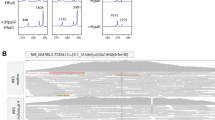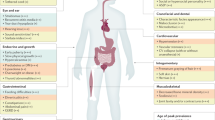Abstract
Dubowitz syndrome is a presumed autosomal recessive disorder characterized by multiple congenital abnormalities: microcephaly, learning and developmental delay, growth failure, and a predisposition to allergies and eczema. There have been more than 150 individuals reported to have this diagnosis, but no unifying genetic alteration has been identified indicating genetic heterogeneity. We report on a pair of monozygotic twins diagnosed clinically with Dubowitz syndrome by Professor Dubowitz over 30 years ago and identified to have a de novo heterozygous 3.2-Mb deletion at 19q13.11q13.12. Exome sequencing did not identify either a putative pathogenic variant on the trans allele supporting recessive inheritance or any other causative sequence variants. Comparison of the phenotype in our cases shows considerable overlap with the 19q13.11 microdeletion syndrome, suggesting that a subset of individuals diagnosed with Dubowitz syndrome may be due to deletions at 19q13. Our finding further reinforces the genetic and phenotypic heterogeneity of Dubowitz syndrome.
Similar content being viewed by others
Main
Dubowitz syndrome (MIM %223370) was first described in 1965 in an individual with growth retardation, eczema and unusual facies.1 Since then more than 150 individuals have been reported, and this syndrome is currently considered as a disorder of multiple congenital abnormalities, intellectual disability and growth failure together with an immune defect predisposing to allergies and eczema.2 It is however clear that there is wide phenotypic heterogeneity with no one feature being consistent in all affected individuals, leading to difficulties in defining the syndrome. This phenotypic heterogeneity is further highlighted by the fact that there have been six different genetic alterations reported in individuals/families with Dubowitz syndrome. Three of these have been microdeletions/duplications involving 13q,3 14q32.34 and 17q24.2,5 respectively. In addition, mutations in NSUN2, LIG4 and PCNT have been described in individuals originally given a diagnosis of Dubowitz syndrome.5, 6, 7, 8
This phenotypic and genetic heterogeneity indicates that Dubowitz syndrome is not a single disorder but actually consists of a number of phenotypically similar but genetically distinct disorders.5 We report here the genetic investigations of monozygotic twins initially diagnosed as having Dubowitz syndrome by Professor Dubowitz over 30 years ago.
The affected individuals are a pair of male monozygotic twins (II-1 and II-2), as confirmed by PowerPlex 16 analysis, from a non-consanguineous white British family (Figure 1). They were born at term (38 weeks) after an uncomplicated pregnancy. Both were small for gestational age with birth weights of 1.98 kg (II-1) and 1.79 kg (II-2), which are <0.4th entile (C). At birth they were also noted to be microcephalic (no record of head circumference is available). Both failed to thrive and individual II-1 was hospitalized for 6 weeks due to poor initial weight gain. They were both noted to have hypospadias and a bifid scrotum at birth, which were later surgically corrected. Strabismus was present in both individuals, which was corrected in both at age 6 years (and again at age 33 years in individual II-2). Both individuals have mild learning disability and had delayed speech. Both had episodes of childhood eczema in their joint flexures, which resolved from teenage years. Despite both having a number of episodes of pneumonia up till the age of 18 months, there have been no reports of further frequent infections. Individual II-1 was noted to have a ventricular septal defect at birth, a feature that was not seen in II-2. The presence of microcephaly, micrognathia, hypospadias, mild learning disability and other characteristic dysmorphic features led to a diagnosis of Dubowitz syndrome (MIM %223370) at age 11 years.
At age 44 years, they are microcephalic with occipitofrontal circumference (OFCs) of 51.5 cm (II-1) and 51.6 cm (II-2) (−2.5 s.d.). Their heights of 176.3 cm (II-1) and 173.3 cm (II-2) are within the normal range. Each brother has a triangular shaped face, with short palpebral fissures, micrognathia, protruding teeth and a high palate (Figure 1). The ears appear relatively long. Both have poor muscle development with long tapering fingers.
Following ethical approvals from the NHS ethics committee (11/H1003/3) and University of Manchester, informed consent was taken from all participants in the study. Copy number analysis using the Affymetrix Genome-wide SNP6.0 assay revealed a 3.2-Mb deletion at hg19 chr19:g.(32 773 586_32 777 549)_(35 990 411_35 998 214) (Figure 1). The deletion was confirmed within individuals II-1 and II-2 using two Taqman copy number assays within the deleted region (Supplementary Figure 1). Both parents had a copy number of two for both probes, demonstrating that the deletion arose de novo and is likely to be causative for the phenotype. Whole-exome sequencing using the Agilent SureSelectXT Human All Exon v5 did not identify any potential pathogenic variants on the trans allele that would have been unmasked by the heterozygous deletion. No potential pathogenic variants were identified in NSUN2, LIG4 or PCNT, previously associated with individuals with Dubowitz syndrome.6, 7
To date, there have been 12 reported cases of deletions at the 19q13.11 locus ranging from 1.4 to 11 Mb9, 10, 11, 12, 13, 14, 15, 16 (MIM #613026), which overlap with the current reported deletion (Figure 2). A comparison between the current cases and those reported with 19q13.11 deletion syndrome demonstrates considerable phenotypic overlap (Table 1). In particular, the individuals reported here have the developmental characteristics (pre- and postnatal growth retardation, developmental and speech delay), similar facial dysmorphic features and the genital abnormalities reported in 19q13.11 deletion syndrome. The history of eczema and their relatively sparse hair suggests that they also had some of the ectodermal features reported previously with 19q13.11 deletions.
Schematic representation of the reported deletion in comparison with previous reported deletions of 19q13.11. Male patients are represented by black bars and female patients are represented by grey bars. Genes within the smallest regions of overlap (SRO) in male and female patients are represented by solid black lines and dashed lines, respectively. All co-ordinates are hg19.
In contrast to previous individuals reported with 19q13.11 deletion syndrome, the twins were not delivered prematurely nor did they have febrile seizures or inguinal hernia. In addition, they did not show many of the differences of the hands or feet that are commonly found in this syndrome apart from the presence of long tapering fingers (Table 1). Further, both individuals have a high palate, which has not been reported in 19q13.11 syndrome but which is present in some individuals with Dubowitz syndrome.2
There are a total of 62 RefSeq genes described on the UCSC genome browser (https://genome.ucsc.edu/) within the current reported deletion (Supplementary Table 1), two of which have been predicted to have a high potential for haploinsufficiency.17 The first of these, UBA2, is within the smallest region of overlap within male individuals with 19q13.11 deletion syndrome. It has been proposed that deletion of this gene together with WTIP is responsible for the urogenital abnormalities in male individuals with this syndrome,12, 13, 14, 15, 16 as both of these genes are deleted in all male patients with 19q13.11 deletions described so far. The second is MAG which encodes the myelin-associated glycoprotein, a protein involved in the maintenance of myelinated axons in both the peripheral and the central nervous system.18 It is therefore possible that deletion of this gene may contribute to the learning disability phenotype seen within patients with 19q13.11 deletion syndrome. However, MAG is not deleted in 2 of the 13 cases of 19q13.11 deletion syndrome reported, and so it is likely that the deletion of other genes may also be responsible for the intellectual disability seen in this syndrome.
This current case brings the number of different genetic alterations identified in individuals with features of Dubowitz syndrome to seven, five of which are already defined genetic syndromes.3, 4, 5, 6, 7, 8 Our current findings reinforce that Dubowitz syndrome does not exist as a single entity but as a collection of phenotypically similar disorders with several underlying genetic causes.5 As four different copy number variants have been described in individuals with clinical features supportive of Dubowitz syndrome, array analysis should be undertaken as a first-line investigation.
References
Dubowitz, V. Familial low birthweight dwarfism with an unusual facies and a skin eruption. J. Med. Genet. 2, 12–17 (1965).
Tsukahara, M. & Opitz, J. M. Dubowitz syndrome: review of 141 cases including 36 previously unreported patients. Am. J. Med. Genet. 63, 277–289 (1996).
Maas, N., Thienpont, B., Vermeesch, J. R. & Fryns, J. P. Facial asymmetry, cardiovascular anomalies and adducted thumbs as unusual symptoms in Dubowitz syndrome: a microdeletion/duplication in 13q. Genet. Couns. 17, 477–479 (2006).
Darcy, D. C., Rosenthal, S. & Wallerstein, R. J. Chromosome deletion of 14q32.33 detected by array comparative genomic hybridization in a patient with features of Dubowitz Syndrome. Case Rep. Genet. 2011, 306072 (2011).
Stewart, D. R., Pemov, A., Johnston, J. J., Sapp, J. C., Yeager, M., He, J. et al. Dubowitz syndrome is a complex comprised of multiple, genetically distinct and phenotypically overlapping disorders. PLoS ONE 9, e98686 (2014).
Martinez, F. J., Lee, J. H., Lee, J. E., Blanco, S., Nickerson, E., Gabriel, S. et al. Whole exome sequencing identifies a splicing mutation in NSUN2 as a cause of a Dubowitz-like syndrome. J. Med. Genet. 49, 380–385 (2012).
Yue, J., Lu, H., Lan, S., Liu, J., Stein, M. N., Haffty, B. G. et al. Identification of the DNA repair defects in a case of Dubowitz syndrome. PLoS ONE 8, e54389 (2013).
Dieks, J.-K., Baumer, A., Wilichowski, E., Rauch, A. & Sigler, M. Microcephalic osteodysplastic primordial dwarfism type II (MOPD II) with multiple vascular complications misdiagnosed as Dubowitz syndrome. Eur. J. Pediatr. 173, 1253–1256 (2014).
Kulharya, A. S., Michaelis, R. C., Norris, K. S., Taylor, H. A. & Garcia-Heras, J. Constitutional del(19)(q12q13.1) in a three-year-old girl with severe phenotypic abnormalities affecting multiple organ systems. Am. J. Med. Genet. 77, 391–394 (1998).
Malan, V., Raoul, O., Firth, H. V., Royer, G., Turleau, C., Bernheim, A. et al. 19q13.11 deletion syndrome: a novel clinically recognisable genetic condition identified by array comparative genomic hybridisation. J. Med. Genet. 46, 635–640 (2009).
Schuurs-Hoeijmakers, J. H. M., Vermeer, S., van Bon, B. W. M., Pfundt, R., Marcelis, C., de Brouwer, A. P. M. et al. Refining the critical region of the novel 19q13.11 microdeletion syndrome to 750 Kb. J. Med. Genet. 46, 421–423 (2009).
Gana, S., Veggiotti, P., Sciacca, G., Fedeli, C., Bersano, A., Micieli, G. et al. 19q13.11 cryptic deletion: description of two new cases and indication for a role of WTIP haploinsufficiency in hypospadias. Eur. J. Hum. Genet. 20, 852–856 (2012).
Shin-Yu, L., Chien-Nan, L., Tai-Chang, C., Mei-Ping, T., Chiou-Ya, L., Tung-Yao, C. et al. A fetus with 19q13.11 microdeletion presenting with intrauterine growth restriction and multiple cystic kidney. Case Rep. Perinat. Med. 1, 69–74 (2012).
Forzano, F., Napoli, F., Uliana, V., Malacarne, M., Viaggi, C., Bloise, R. et al. 19q13 microdeletion syndrome: further refining the critical region. Eur. J. Med. Genet. 55, 429–432 (2012).
Chowdhury, S., Bandholz, A. M., Parkash, S., Dyack, S., Rideout, A. L., Leppig, K. A. et al. Phenotypic and molecular characterization of 19q12q13.1 deletions: a report of five patients. Am. J. Med. Genet. 164A, 62–69 (2014).
Venegas-Vega, C., Nieto-Martínez, K., Martínez-Herrer, A., Gómez-Laguna, L., Berumen, J., Cervantes, A. et al. 19q13.11 microdeletion concomitant with ins(2;19)(p25.3;q13.1q13.4)dn in a boy: potential role of UBA2 in the associated phenotype. Mol. Cytogenet 7, 61 (2014).
Huang, N., Lee, I., Marcotte, E. M. & Hurles, M. E. Characterising and predicting haploinsufficiency in the human genome. PLoS Genet. 6, e1001154 (2010).
Quarles, R. H. Myelin-associated glycoprotein (MAG): past, present and beyond. J. Neurochem. 100, 1431–1448 (2007).
Acknowledgements
The authors would like to acknowledge the support of the Manchester Academic Health Science Centre and the Manchester Biomedical Research Centre.
Author information
Authors and Affiliations
Corresponding author
Ethics declarations
Competing interests
The authors declare no conflict of interest
Additional information
Supplementary Information accompanies the paper on Journal of Human Genetics website
Supplementary information
Rights and permissions
About this article
Cite this article
Urquhart, J., Williams, S., Bhaskar, S. et al. Deletion of 19q13 reveals clinical overlap with Dubowitz syndrome. J Hum Genet 60, 781–785 (2015). https://doi.org/10.1038/jhg.2015.111
Received:
Revised:
Accepted:
Published:
Issue Date:
DOI: https://doi.org/10.1038/jhg.2015.111





